The Puerto Rican Emerald (Riccordia maugaeus) stands as a living jewel amidst the tropical splendor of Puerto Rico.
As an endemic hummingbird species, its diminutive size belies a captivating vibrancy, with iridescent green plumage and a striking turquoise throat patch in males.
This avian gem, measuring 3 to 3.5 inches in length, graces the island’s montane forests and coffee plantations.
Renowned for its aerial acrobatics, the Puerto Rican Emerald sustains itself through a nectar-centric diet, contributing to vital pollination processes within its habitat.
Nestling within the order of Apodiformes, this species navigates the Strisores clade, emphasizing its swift and agile flight.
With a taxonomy rooted in the Animalia kingdom and Chordata phylum, the Puerto Rican Emerald exemplifies the ecological richness of Puerto Rico, embodying both the fragility and resilience of its unique island ecosystem. Stay focused.
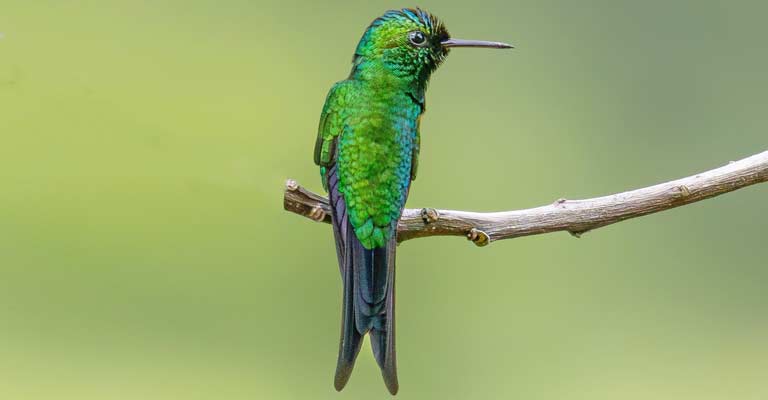
Identifying Characteristics of Puerto Rican Emerald
The Puerto Rican Emerald (Chlorostilbon maugaeus) is a small and captivating hummingbird species endemic to the island of Puerto Rico.
Identifying this bird involves paying attention to various distinctive characteristics, from its size and plumage to its behavior and habitat preferences.
Size and Shape
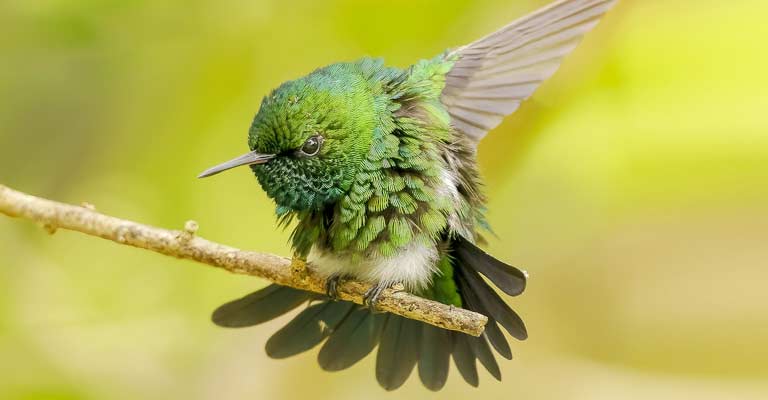
The Puerto Rican Emerald is a diminutive bird, measuring around 3 to 3.5 inches (7.5 to 9 cm) in length. It boasts a slender, streamlined body with iridescent green feathers covering its back and head.
The tail is forked and extends beyond its wingtips, contributing to its overall aerodynamic appearance.
Iridescent Plumage
One of the most striking features of this hummingbird is its vibrant iridescent plumage. The male exhibits a brilliant green coloration on its upperparts, while the female tends to have a slightly duller green.
The throat of the male is a dazzling turquoise or blue hue, adding to its visual appeal.
Distinctive Throat Patch
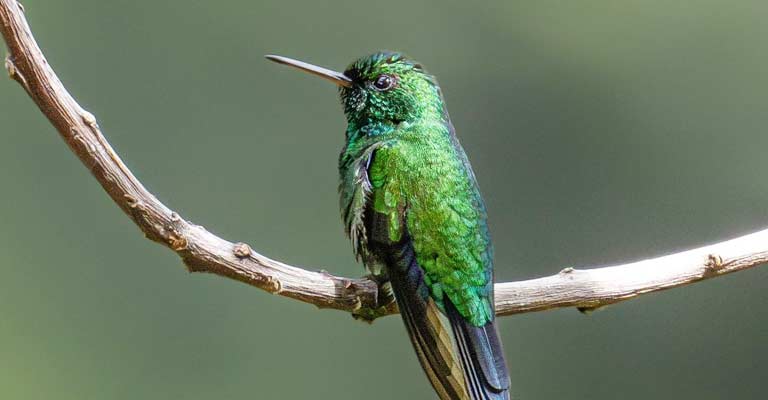
The throat patch, also known as the gorget, is a key identification feature. In the male, this patch is a radiant, iridescent blue, creating a vivid contrast with the rest of its plumage.
The female, on the other hand, usually lacks the intense coloring on the throat and may have a more subdued or whitish patch.
Flight Pattern
Observing the flight pattern of the Puerto Rican Emerald can aid in identification. These hummingbirds are agile fliers, capable of hovering and rapid maneuvering.
Their wings beat at an incredible speed, and they often emit a distinctive buzzing sound while in flight.
Habitat Preference
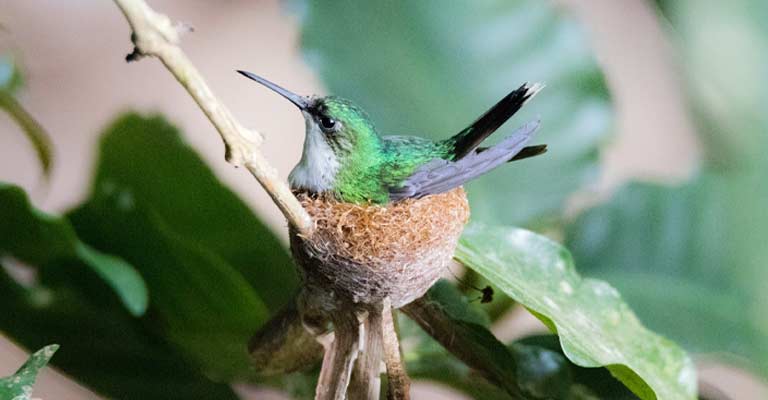
Understanding the habitat preferences of this species is crucial for identification. The Puerto Rican Emerald is primarily found in the montane forests and coffee plantations of Puerto Rico.
It favors areas with abundant flowering plants, where it can feed on nectar.
Behavioral Traits
The feeding behavior of the Puerto Rican Emerald involves hovering near flowers and using its specialized bill to extract nectar.
Additionally, they may consume small insects and spiders as a source of protein. Observing these feeding habits can provide valuable clues for identification.
Vocalizations
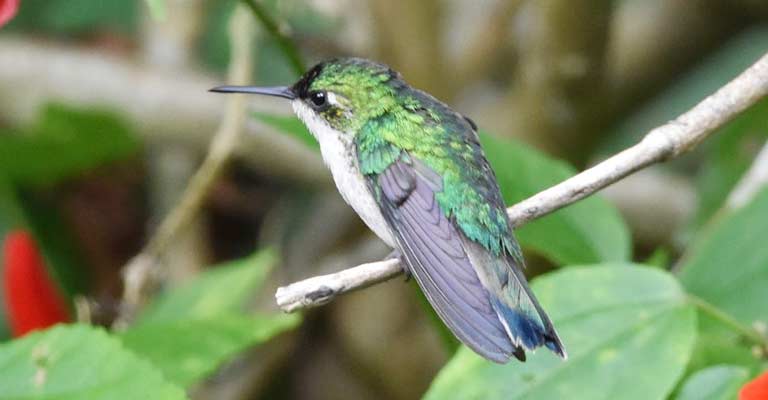
While not as vociferous as some other bird species, the Puerto Rican Emerald does produce distinct vocalizations.
These may include soft chirps or whistles. Familiarizing oneself with these subtle sounds can be useful in identifying the presence of these hummingbirds in an area.
Range and Endemism
The Puerto Rican Emerald is endemic to Puerto Rico, meaning it is not found anywhere else in the world.
Therefore, if you spot a small hummingbird with the aforementioned characteristics within the island’s boundaries, there is a high likelihood that it is the unique and enchanting Puerto Rican Emerald.
Identifying the Puerto Rican Emerald involves a combination of visual and behavioral cues, from its iridescent plumage and distinctive throat patch to its agile flight and habitat preferences.
Taxonomy of Puerto Rican Emerald
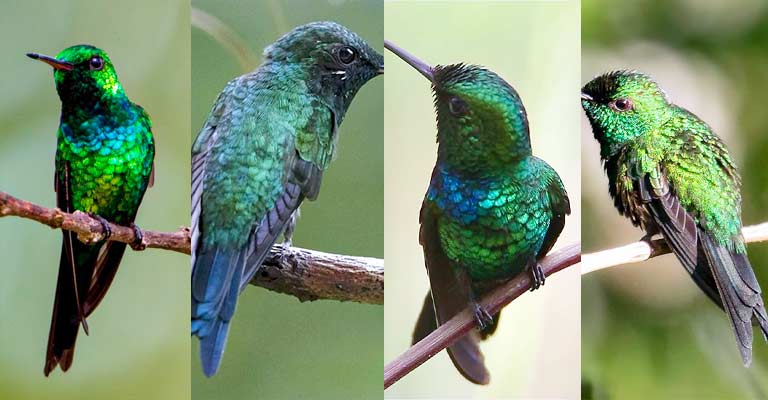
Here is a table summarizing the taxonomy details of the Puerto Rican Emerald:
| Taxonomy Level | Classification |
| Domain | Eukaryota |
| Kingdom | Animalia |
| Phylum | Chordata |
| Class | Aves |
| Clade | Strisores |
| Order | Apodiformes |
| Family | Trochilidae |
| Genus | Riccordia |
| Species | R. maugaeus |
The Puerto Rican Emerald, scientifically known as Riccordia maugaeus, belongs to the Animalia kingdom within the Eukaryota domain.
This taxonomy classification provides a systematic understanding of the bird’s evolutionary relationships and its place within the broader classification of life.
The Puerto Rican Emerald, scientifically classified as Riccordia maugaeus, belongs to the Animalia kingdom, Chordata phylum, and Aves class.
It is a member of the Trochilidae family within the order Apodiformes, a group known for swift aerial movements.
As a hummingbird, it falls under the Strisores clade. The genus Riccordia is specific to this species, identified as maugaeus.
This taxonomy succinctly places the Puerto Rican Emerald within the broader context of the animal kingdom, highlighting its avian nature, unique characteristics, and evolutionary relationships.
Puerto Rican Emerald Life History
The Puerto Rican Emerald (Chlorostilbon maugaeus) stands as a jewel among the avian residents of Puerto Rico.
Its life history is a fascinating narrative, encompassing various aspects such as feeding habits, preferred habitats, nesting behaviors, conservation challenges, and ongoing efforts to ensure its survival.
Food
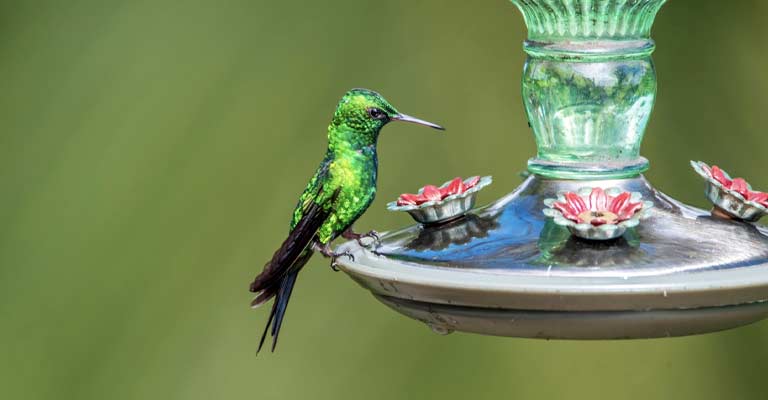
The primary sustenance of the Puerto Rican Emerald revolves around a nectar-centric diet.
These diminutive hummingbirds utilize their specialized bills to extract nectar from a plethora of flowering plants within their habitat.
In addition to nectar, they supplement their diet with small insects and spiders, contributing essential proteins to their nutrition.
This eclectic feeding behavior underscores their ecological role as pollinators within their native ecosystem.
Habitat
The Puerto Rican Emerald displays a strong affinity for montane forests and coffee plantations, where an abundance of flowering plants provides ample nectar sources.
This preference for specific habitats reflects the bird’s adaptation to its environment and underscores the delicate balance required for its survival.
Range Map
Endemic to Puerto Rico, the range map of the Puerto Rican Emerald is confined to this Caribbean island.
The species’ distribution is intricately linked to the availability of suitable habitats, emphasizing the need for conservation efforts within its limited geographic range.
Nesting
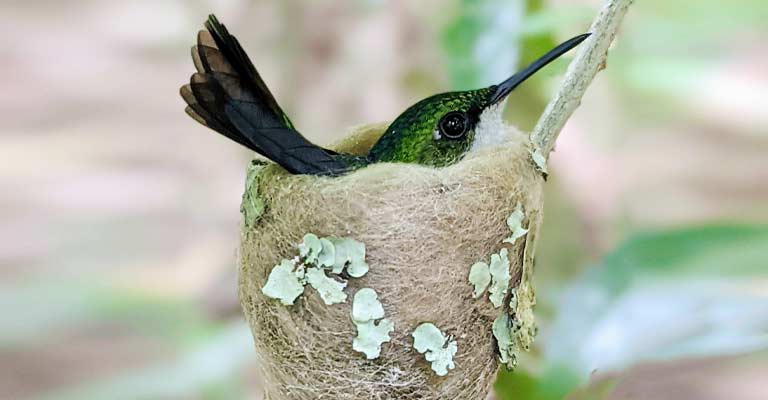
Nesting behavior is a crucial aspect of the Puerto Rican Emerald’s life history. Females meticulously construct cup-shaped nests using plant fibers, spider silk, and other natural materials.
These nests are often nestled in the branches of trees, providing a secure environment for incubating eggs and raising offspring.
Here is a table summarizing the nesting details of the Puerto Rican Emerald:
| Nesting Details | Facts |
| Clutch Size | Usually 2 eggs, occasionally 1 or 3 |
| Number of Broods | Typically 1, but may attempt 2 in a year |
| Egg Length | Approximately 1.1 cm (0.43 inches) |
| Egg Width | Around 0.6 cm (0.24 inches) |
| Incubation Period | Approximately 14-15 days |
| Nestling Period | About 20-22 days |
| Egg Description | Small, white or slightly pinkish, with a rounded shape |
| Nest Construction | Cup-shaped, made of plant fibers, spider silk, and other natural materials |
| Nest Placement | Positioned on branches, often in the canopy of trees |
| Incubation and Parental Care | Female is primarily responsible for incubation, while both parents participate in feeding and caring for the nestlings |
| Fledgling Stage | After the nestling period, young birds fledge and gradually become independent |
| Nest Reuse | The Puerto Rican Emerald may reuse nests for subsequent broods or construct new ones for each breeding attempt |
Understanding these nesting details provides valuable insights into the reproductive biology and life history of the Puerto Rican Emerald, contributing to conservation efforts aimed at ensuring the species’ continued success.
Breeding
Breeding in the Puerto Rican Emerald typically occurs during the island’s rainy season, ensuring a steady supply of nectar and insects for the growing chicks.
Males engage in courtship displays, showcasing their vibrant plumage and agility in flight to attract potential mates.
The species’ reproductive success is intricately tied to the availability of suitable nesting sites and the abundance of food resources.
Diseases
As with many wildlife species, the Puerto Rican Emerald is not immune to the threats posed by diseases.
Avian diseases, particularly those transmitted by vectors such as mosquitoes, can impact their health and reproductive success.
Monitoring and understanding disease dynamics are essential components of conservation efforts aimed at ensuring the long-term viability of the species.
Treatment
Addressing diseases in the Puerto Rican Emerald involves a multi-faceted approach. Research on disease ecology, early detection, and prompt intervention are critical components.
Collaborative efforts between scientists, conservationists, and local communities play a pivotal role in implementing effective treatment strategies, which may include habitat management, vaccination programs, and public awareness campaigns.
Conservation
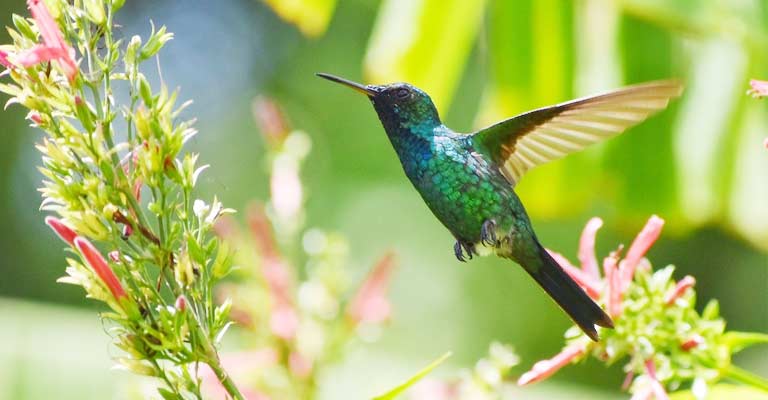
The conservation status of the Puerto Rican Emerald underscores the urgency of preserving its habitat and addressing potential threats.
Habitat loss, climate change, and the introduction of invasive species pose significant challenges.
Conservation initiatives focus on safeguarding critical habitats, implementing sustainable land-use practices, and raising awareness to garner support for the protection of this endemic species.
The life history of the Puerto Rican Emerald is a tapestry woven with intricate ecological interactions and conservation imperatives.
Understanding and appreciating these facets are crucial for fostering a comprehensive approach to the species’ conservation and ensuring that this vibrant jewel of Puerto Rico continues to grace its ecosystems for generations to come.
10 Fun Facts About Puerto Rican Emerald
The Puerto Rican Emerald, a charming hummingbird endemic to the tropical paradise of Puerto Rico, boasts a myriad of fascinating features that contribute to its unique charm.
Here are 10 fun facts about this enchanting avian species:
- Endemic Elegance: The Puerto Rican Emerald is exclusively found on the island of Puerto Rico, making it a true symbol of the region’s biodiversity and a point of pride for locals.
- Diminutive Dimensions: Despite its small size, with a length of approximately 3 to 3.5 inches, the Puerto Rican Emerald is a master of aerial acrobatics, showcasing agility and precision in flight.
- Iridescent Splendor: The males of this species sport a vibrant, iridescent green plumage, coupled with a dazzling turquoise or blue throat patch, creating a living jewel effect that captivates onlookers.
- Nectar Niche: Like other hummingbirds, the Puerto Rican Emerald is a nectar specialist, relying on the sweet sustenance of flowers to meet its energy needs. It plays a vital role as a pollinator within its habitat.
- Forked Tail Flourish: The distinctive forked tail of the Puerto Rican Emerald adds to its charm, contributing to its streamlined appearance and aiding in precise flight maneuvers.
- Limited Lullabies: Despite their diminutive size, these hummingbirds are not known for their vocal prowess. Their calls are soft and infrequent, in contrast to the more vocal members of the bird kingdom.
- Rainy Romance: Breeding among Puerto Rican Emeralds is often synchronized with the rainy season, ensuring an abundance of nectar and insects for the growing chicks.
- Nest Masterpiece: The females construct intricate cup-shaped nests using plant fibers, spider silk, and other natural materials. These nests are often nestled in the branches of trees, showcasing the bird’s architectural finesse.
- Precious Parenting: Parental duties are shared between the male and female, with both contributing to feeding and caring for the nestlings during the incubation and nestling periods.
- Conservation Concern: Despite its resilience, the Puerto Rican Emerald faces threats such as habitat loss and the introduction of invasive species. Conservation efforts are underway to protect its unique habitat and ensure the survival of this captivating species.
The Puerto Rican Emerald is not merely a bird; it is a symbol of Puerto Rico’s natural splendor, a jewel of the skies that adds vibrancy and life to the island’s rich biodiversity.
Wrapping Up
In the lush landscapes of Puerto Rico, the Puerto Rican Emerald stands as a testament to the island’s ecological richness. Its diminutive size belies a world of vibrant colors, aerial prowess, and intricate nesting habits.
As a symbol of endemism, the hummingbird weaves a tale of resilience and adaptation, facing conservation challenges that echo broader environmental concerns.
Understanding its life history, nesting details, and unique characteristics is not just a journey into ornithology; it’s a glimpse into the delicate balance of nature in this Caribbean gem.
The Puerto Rican Emerald, with its iridescent allure and ecological significance, invites us to appreciate the interconnected web of life and engage in efforts to safeguard the diverse wonders of our planet. Thank you for your support.